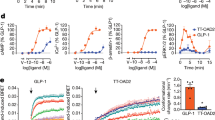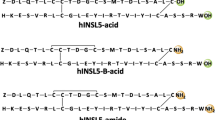Abstract
The elucidation of the mechanisms involved in the biological actions of the IGFs has been hampered by the complexity of the IGF system: three peptide ligands (IGF-I, IGF-II and insulin),1 three receptors (type 1 and type 2 IGF receptors and insulin receptors)2 and six distinct, but structurally related binding proteins (IGFBP-1 to IGFBP-6).3 The physiological interactions among these components of the IGF system are not completely understood, although they have all been cloned and sequenced.4
Access this chapter
Tax calculation will be finalised at checkout
Purchases are for personal use only
Preview
Unable to display preview. Download preview PDF.
Similar content being viewed by others
References
M.M. Rechler and S.P. Nissley, Insulin-like growth factors, in: “Handbook of Experimental Pharmacology”, Vol. 95/I, “Peptide Growth Factors and Their Receptors I”, M.B. Sporn and A.B. Roberts, eds., Springer-Verlag, Berlin (1990).
Y. Oh, H.L. Müller, E.K. Neely, G. Lamson, and R.G. Rosenfeld, New concepts in insulin-like growth factor receptor physiology, Growth Regulation (in press).
R.G. Rosenfeld, G. Lamson, H. Pham, Y. Oh, C. Conover, D.D. De Leon, S.M. Donovan, I. Ocrant, and L.C. Giudice, Insulin-like growth factor binding Proteins, Rec. Prog. Horm. Res. 46:99 (1990).
G. Steele-Perkins, J. Turner, J.C. Edman, J. Hari, S.B. Pierce, C. Stover, W.J. Rutter, and R.A. Roth, Expression and characterization of a functional human insulin-like growth factor I receptor, J. Biol. Chem. 263:11486 (1988).
S. Shimasaki and N. Ling, Identification and molecular characterization of insulin-like growth factor binding proteins (IGFBP-1,-2,-3,-4,-5, and -6), Prog. Growth Factor Res. 3:243 (1991).
D.O. Morgan, J.C. Edman, D.N. Standring, V.A. Fried, M.C. Smith, R.A. Roth, and W.J. Rutter, Insulinlike growth factor II receptor as a multifunctional binding protein, Nature 329:301 (1987).
R.G. MacDonald, S.R. Pfeffer, L. Coussens, M.A. Tepper, C.M. Brocklebank, J.E. Mole, J.K. Anderson, E. Chen, M.P. Czech, and A. Ullrich, A single receptor binds both insulin-like growth factor-II and mannose-6-phosphate, Science 239:1134 (1988).
P.Y. Tong, S.E. Tollefsen, and S. Kornfeld, The cation-independent mannose-6-phosphate receptor binds insulin-like growth factor II, J. Biol. Chem. 263:2585 (1988).
Y. Oh, H.L. Müller, H. Pham, G. Lamson, and R.G. Rosenfeld, Non-receptor mediated, post-transcriptional regulation of insulin-like growth factor binding protein-3 in Hs578T human breast cancer cells, Endocrinology 131:3123 (1992).
C. Camacho-Hubner, W.H.Jr. Busby, R.H. McCusker, G. Wright, and D.R. Clemmons, Identification of the forms of insulin-like growth factor-binding proteins produced by human fibroblasts and the mechanisms that regulate their secretion, J. Biol. Chem. 267:11949 (1992).
C.A. Conover, P. Misra, R.L. Hintz, and R.G. Rosenfeld, Effect of an anti-insulin-like growth factor I receptor antibody on insulin-like growth factor II stimulation of DNA synthesis in human fibroblasts, Biochem. Biophys. Res. Commun. 139:501 (1987).
J. Hari, S.B. Pierce, D.O. Morgan, V. Sara, M.C. Smith, and R.A. Roth, The receptor for insulin-like growth factor II mediates an insulin-like response, EMBO J. 6:3367 (1987).
I. Kojima, I. Nishimoto, T. Iiri, E. Ogata, and R.G. Rosenfeld, Evidence that type II insulin-like growth factor receptor is coupled to calcium gating system, Biochem. Biophys. Res. Commun. 154:9 (1988).
C. Mottola and M.P. Czech, The type II insulin-like growth factor receptor does not mediate increased DNA synthesis in H-35 hepatoma cells, J. Biol. Chem. 259:12705 (1984).
E.Y. Adashi, C.E. Resnick, and R.G. Rosenfeld, Insulin-like growth factor -I (IGF-I) hormonal action in cultured rat granulosa cells: Mediation via type I but not type II IGF receptors, Endocrinology 126:216 (1989).
G. Steele-Perkins and R.A. Roth, Monoclonal antibody alphaIR3 inhibits the ability of insulin-like growth factor II to stimulate a signal from the type-I receptor without inhibiting its binding, Biochem. Biophys. Res. Commun. 171:1244 (1990).
G. Steele-Perkins and R.A. Roth, Insulin-mimetic anti-insulin receptor monoclonal antibodies stimulate receptor kinase activity in intact cells, J. Biol. Chem. 265:9458 (1990).
T.L. Blundell, S. Berdarka, E. Rinderknecht, and R.E. Humbel, Insulin-like growth factor: A model for tertiary structure accounting for immunoreactivity and receptor binding, Biochemistry 75:180 (1978).
M.A. Cascieri and M.L. Bayne, Identification of the domains of IGF-I which interact with the IGF receptors and binding proteins, in: “Molecular and Cellular Biology of Insulin-like Growth Factors and Their Receptor”, D. ReRoith and M.K. Raizada, eds., Plenum Press, NY (1989).
M.L. Bayne, J. Applebaum, G.G. Chicchi, N.S. Hayes, B.G. Green, and M.A. Cascieri, Structural analogs of human insulin-like growth factor I with reduced affinity for serum binding proteins and the type 2 insulin-like growth factor receptor, J. Biol. Chem. 263:6233 (1988).
M.A. Cascieri, G.G. Chicchi, J. Applebaum, B.G. Green, N.S. Hayes, and M.L. Bayne, Structural analogs of human insulin-like growth factor (IGF) I with altered affinity for type 2 IGF receptors J. Biol. Chem. 264:2199 (1989).
ML. Bayne, J. Applebaum, G.G. Chicchi, R.E. Miller, and M.A. Cascieri, The role of tyrosines 24, 31, and 60 in the high affinity binding of insulin-like growth factor-I to the type 1 insulin-like growth factor receptor, J. Biol. Chem. 265:15648 (1990).
N. Ling, F. Esch, P. Böhlen, P. Brazeau, W.B. Wehrenberg, and R. Guillemin, Isolation, primary structure and synthesis of human hypothalamic somatocrinin: Growth hormone-releasing factor, Proc. Nat. Acad. Sci. USA. 81:4302 (1984).
J.P. Tam, W.F. Heath, and R.B. Merrifield, SN2 deprotection of synthetic peptides with a low concentration of HF in dimethylsulfide: Evidence and application in peptide synthesis, J. Am. Chem. Soc. 105:6442 (1983).
M.W. Beukers, Y. Oh, H. Zhang, N. Ling, and R.G. Rosenfeld, [Leu27]insulin-like growth factor II is highly selective for the type-II IGF receptor in binding, cross-linking and thymidine incorporation experiments, Endocrinology 128:1201 (1991).
Y. Oh, H.L. Müller, D. Lee, P. J. Fielder, and R.G. Rosenfeld, Characterization of the affinities of insulinlike growth factor (IGF)-binding proteins 1-4 for IGF-I, IGF-II, IGF/insulin hybrid, and IGF-I analogs, Endocrinology 132:1337 (1993).
M.C. Kiefer, C.S. Schmid, M. Waldvogel, I.Schläpfer, E. Futo, F.R. Masiarz, K. Green, P.J. Barr, and J. Zapf, Characterization of recombinant human insulin-like growth factor binding proteins 4, 5, and 6 produced in Yeast, J. Biol. Chem. 267:12692 (1992).
Y. Oh, M.W. Beukers, H. Pham, P.A. Smanik, M.C. Smith, and R.G. Rosenfeld, Altered affinity of insulin-like growth factor II (IGF-II) for receptors and IGF-binding proteins, resulting from limited modifications of the IGF-II molecule, Biochem. J. 278:249 (1991).
D.M. Bürgisser, B.V. Rith, R. Giger, C. Lüthi, S. Weigl, J. Zarn, and R.E. Humbel, Mutants of human insulin-like growth factor II with altered affinities for the type 1 and type 2 insulin-like growth factor receptor, J. Biol. Chem. 266:1029 (1991).
K. Sakano, T. Enjoh, F. Numata, H. Fujiwara, Y. Marumoto, N. Higashihashi, Y. Sato, J.F. Perdue, and Y.F. Yamaguchi, The design, expression, and characterization of human insulin-like growth factor II (IGF-II) mutants specific for either the IGF-II/cation-independent mannose 6-phosphate receptor or IGF-I receptor, J. Biol. Chem. 266:20626 (1991).
W. Kiess, G.D. Blickenstaff, M.M. Sklar, C.L. Thomas, S.P. Nissley, and G.C. Sahagian, Biochemical evidence that type II insulin-like growth factor receptor is identical to the cation-independent mannose 6-phosphate receptor, J. Biol. Chem. 263:9339 (1988).
W. Kiess, C.L. Thomas, M.M. Sklar, and S.P. Nissley, ß-galactosidase decreases the binding affinity of the insulin-like growth factor II/mannose 6-phosphate receptor for insulin-like growth factor II, Eur. J. Biochem. 190:71 (1990).
I. Nishimoto, Y. Hata, E. Ogata, and I, Kojima, Insulin-like growth factor II stimulates calcium influx in competent Balb/c 3T3 cells primed with epidermal growth factor: Characteristics of calcium influx and involvement of GTP-binding protein, J. Biol. Chem. 262:12120 (1987).
T. Okamoto, T. Katada, Y. Murayama, M Ui, E. Ogata, and I. Nishimoto, A simple structure encodes G protein-activating function of the IGF-II/mannose 6-phosphate receptor, Cell 62:709 (1990).
O.M. El-Badry, C.P. Minniti, E.C. Kohn, P.J. Houghton, W.H. Daughaday, and L.J. Helman, Insulin-like growth factor II acts as an autocrine growth and motility factor in human rhabdomyosarcoma tumors, Cell Growth &Differ. 1:325 (1990).
C.P. Minniti, E.C. Kohn, J.H. Grubb, W.S. Sly, Y. Oh, H.L. Müller, R.G. Rosenfeld, and L.J. Helman, The insulin-like growth factor II (IGF-II)/mannose 6-phosphate receptor mediates IGF-II-induced motility in human rhabdomyosarcoma cells, J. Biol. Chem. 267:9000 (1992).
J. Delbé, C. Blat, G. Desauty, and L. Harel, Presence of IDF45 (mIGFBP-3) binding sites on chick embryo fibroblasts, Biochem. Biophys. Res. Commun. 179:495 (1991).
J.L. Martin, M. Ballesteros, and R.C. Baxter, Insulin-like growth factor-I (IGF-I) and transforming growth factor-ß1 release IGF-binding protein-3 from human fibroblasts by different mechanisms, Endocrinology131:1703 (1992).
Y. Oh, H.L. Müller, H. Pham, G. Lamson, and R.G. Rosenfeld, Insulin-like growth factor binding protein (IGFBP)-3 levels in conditioned media of Hs578T human breast cancer cells are post-transcriptionally regulated, Growth Regulation 3:84 (1993).
Y. Oh, H.L. Müller, G. Lamson, and R.G. Rosenfeld, Insulin-like growth factor (IGF)-independent action of IGF binding protein (BP)-3 in Hs578T human breast cancer cells: cell surface binding and growth inhibition, J. Biol. Chem. (in press).
D.D. DeLeon, D.M. Wilson, M. Powers, and R.G. Rosenfeld, Effects of insulin-like growth factors (IGFs) and IGF receptor antibodies on the proliferation of human breast cancer cells, Growth Factors 6:327 (1992).
B.W. Ennis, E.M. Valverius, S.E. Bates, M.E. Lippman, F. Bellot, R. Kris, J. Schlessinger, H. Masui, A. Goldenberg, J. Mendelsohn, and R.B. Dickson, Anti-epidermal growth factor receptor antibodies inhibit the autocrine-stimulated growth of MDA-468 human breast cancer cells, Mol. Endocrinol 3:1830 (1989).
M.H. Kraus, Y. Yuasa, and S.A. Aaronson, A position 12-activated H-ras oncogene in all Hs578T mammary carcinosarcoma cells but not normal mammary cells of the same patient, Biochemistry 81:5384(1984).
Author information
Authors and Affiliations
Editor information
Editors and Affiliations
Rights and permissions
Copyright information
© 1994 Springer Science+Business Media New York
About this chapter
Cite this chapter
Oh, Y., Müller, H.L., Zhang, H., Ling, N., Rosenfeld, R.G. (1994). Synthesis and Characterization of IGF-II Analogs: Applications in the Evaluation of IGF Receptor Function and IGF-Independent Actions of IGFBPS. In: Le Roith, D., Raizada, M.K. (eds) Current Directions in Insulin-Like Growth Factor Research. Advances in Experimental Medicine and Biology, vol 343. Springer, Boston, MA. https://doi.org/10.1007/978-1-4615-2988-0_5
Download citation
DOI: https://doi.org/10.1007/978-1-4615-2988-0_5
Publisher Name: Springer, Boston, MA
Print ISBN: 978-1-4613-6301-9
Online ISBN: 978-1-4615-2988-0
eBook Packages: Springer Book Archive




